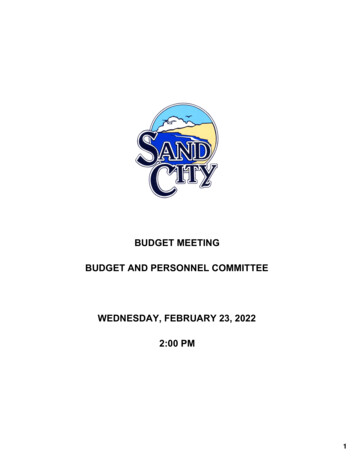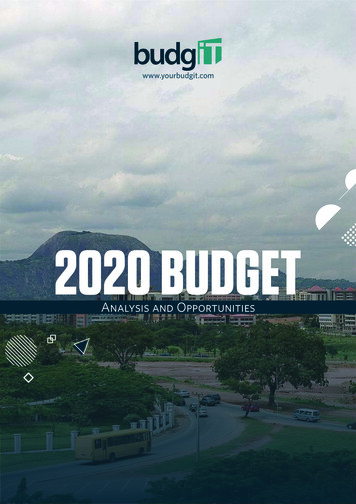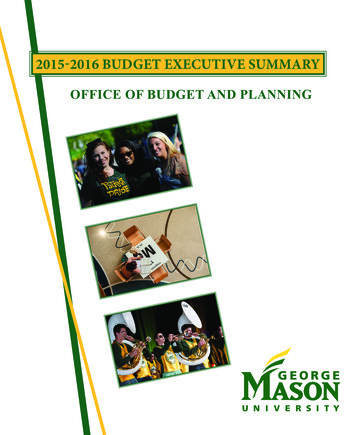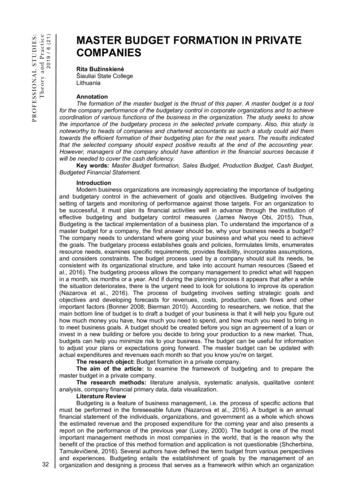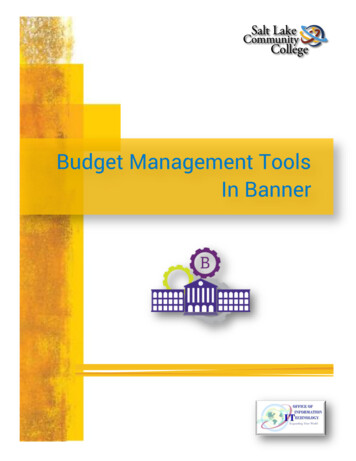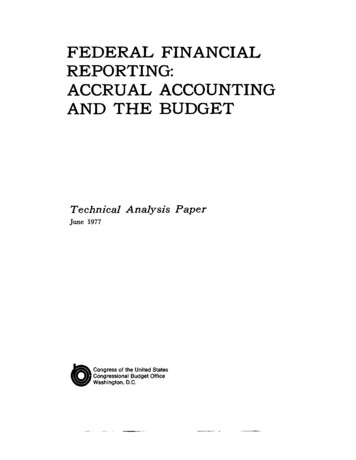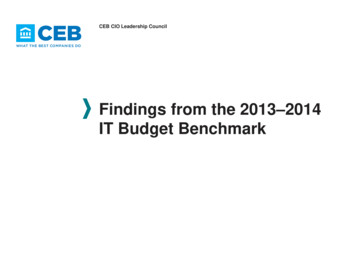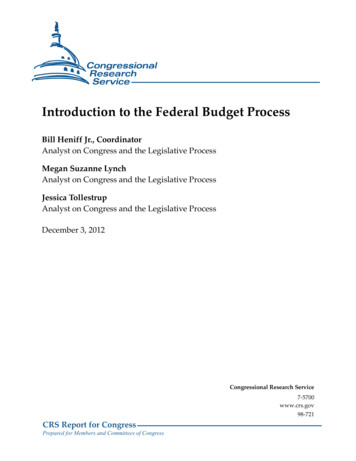
Transcription
Introduction to the Federal Budget ProcessBill Heniff Jr., CoordinatorAnalyst on Congress and the Legislative ProcessMegan Suzanne LynchAnalyst on Congress and the Legislative ProcessJessica TollestrupAnalyst on Congress and the Legislative ProcessDecember 3, 2012Congressional Research Service7-5700www.crs.gov98-721CRS Report for CongressPrepared for Members and Committees of Congress
Introduction to the Federal Budget ProcessSummaryBudgeting for the federal government is an enormously complex process. It entails dozens ofsubprocesses, countless rules and procedures, the efforts of tens of thousands of staff persons inthe executive and legislative branches, millions of work hours each year, and the activeparticipation of the President and congressional leaders, as well as other members of Congressand executive officials.The enforcement of budgetary decisions involves a complex web of procedures that encompassesboth congressional and executive actions. In the last four decades or so, these procedures havebeen rooted principally in two statutes—the Congressional Budget Act of 1974 and the BalancedBudget and Emergency Deficit Control Act of 1985. The 1974 act established a congressionalbudget process in which budget policies are enforced by Congress during the consideration ofindividual measures. The 1985 act embodies additional statutory enforcement procedures,substantially modified in 1990 and 1997, that have been used by the executive to enforce budgetpolicies after the end of a congressional session. The 1997 iteration of these enforcementprocedures were set aside in the latter years of their existence and effectively expired toward theend of the 107th Congress. Efforts to renew them in the 108th through 110th Congresses were notsuccessful. In the 111th Congress, the pay-as-you-go procedures affecting direct spending andrevenue legislation were restored in a modified version by the Statutory Pay-As-You-Go Act of2010. More recently, in the 112th Congress, statutory limits on discretionary spending and a newautomatic process to reduce spending were established by the Budget Control Act of 2011.The President’s budget is required by law to be submitted to Congress early in the legislativesession. While the budget is only a request to Congress, the power to formulate and submit thebudget is a vital tool in the President’s direction of the executive branch and of national policy.The President’s proposals often influence congressional revenue and spending decisions, thoughthe extent of the influence varies from year to year and depends more on political and fiscalconditions than on the legal status of the budget.The Congressional Budget Act of 1974 establishes the congressional budget process as the meansby which Congress coordinates the various budget-related actions (such as the consideration ofappropriations and revenue measures) taken by it during the course of the year. The process iscentered on an annual concurrent resolution on the budget that sets aggregate budget policies andfunctional spending priorities for at least the next five fiscal years. Because a concurrentresolution is not a law—it cannot be signed or vetoed by the President—the budget resolutiondoes not have statutory effect; no money can be raised or spent pursuant to it. Revenue andspending amounts set in the budget resolution establish the basis for the enforcement ofcongressional budget policies through points of order.Congress implements budget resolution policies through action on individual revenue and debtlimit measures, annual appropriations acts, and direct spending legislation. In some years,Congress considers reconciliation legislation pursuant to reconciliation instructions in the budgetresolution. Reconciliation legislation is used mainly to bring existing revenue and direct spendinglaws into conformity with budget resolution policies. Initially, reconciliation was a major tool fordeficit reduction; in later years, reconciliation was used mainly to reduce revenues.Congressional Research Service
Introduction to the Federal Budget ProcessContentsThe Evolution of Federal Budgeting . 1Basic Concepts of Federal Budgeting . 2Budget Authority and Outlays . 2Scope of the Budget. 3Deficit Reduction and the Rules of Congressional Budgeting . 4Budgeting for Discretionary and Direct Spending. 6Budgeting for Direct and Guaranteed Loans . 9The Budget Cycle . 9The Presidential Budget Process. 9Formulation and Content of the President’s Budget . 10Executive Interaction with Congress . 11The Congressional Budget Process. 11Formulation and Content of the Budget Resolution . 12Budget Resolution Enforcement . 14Budget Resolution Aggregates . 14Allocations of Spending to Committees. 14Scoring and Cost Estimates . 15Points of Order . 15The Sequestration Process . 16Spending Legislation . 19Authorizing Measures . 20The Annual Appropriations Process . 20Revenue Legislation . 22Debt-Limit Legislation . 23Reconciliation Legislation . 24Reconciliation Directives . 24Development and Consideration of Reconciliation Measures. 25House and Senate Earmark Disclosure Rules . 26House of Representatives . 26The Senate . 27Impoundment and Line-Item Veto . 28Impoundment . 28Rescissions . 28Deferrals . 28Line-Item Veto . 29TablesTable 1. Congressional Budget Process Timetable . 12Congressional Research Service
Introduction to the Federal Budget ProcessContactsAuthor Contact Information. 30Acknowledgments . 30Congressional Research Service
Introduction to the Federal Budget ProcessThe Evolution of Federal BudgetingThe “power of the purse” is a legislative power. The Constitution lists the power to lay and collecttaxes and the power to borrow as powers of Congress; further, it provides that funds may bedrawn from the Treasury only pursuant to appropriations made by law. The Constitution does notstate how these legislative powers are to be exercised, nor does it expressly provide for thePresident to have a role in the management of the nation’s finances.During the nation’s early years, the House and Senate devised procedures for the enactment ofspending and revenue legislation. As these procedures evolved during the 19th century and thefirst decades of the 20th century, they led to highly fragmented legislative actions. In the course ofeach session, Congress passed many separate appropriations bills and other measures affectingthe financial condition of the federal government. Neither the Constitution nor the proceduresadopted by the House and Senate provided for a budget system—that is, for a coordinated set ofactions covering all federal spending and revenues. As long as the federal government was smalland its spending and revenues were stable, such a budget system was not considered necessary.Early in the 20th century, the incessant rise in federal spending and the recurrence of deficits(spending exceeded revenues in half of the 20 years preceding FY1920) led Congress to seek amore coordinated means of making financial decisions. The key legislation was the Budget andAccounting Act of 1921, which established the executive budget process.The 1921 act did not directly alter the procedures by which Congress makes revenue andspending decisions. The main impact was in the executive branch. The President was required tosubmit his budget recommendations to Congress each year, and the Bureau of the Budget—renamed the Office of Management and Budget (OMB) in 1970—was created to assist him incarrying out his budgetary responsibilities. Congress, it was expected, would be able tocoordinate its revenue and spending decisions if it received comprehensive budgetrecommendations from the President. In line with this expectation, the House and Senate changedtheir rules to consolidate the jurisdiction of the Appropriations Committees over spending. The1921 act also established the General Accounting Office (GAO), headed by the ComptrollerGeneral, and made it the principal auditing arm of the federal government. (The GAO recentlywas renamed the Government Accountability Office.) The 1921 act, as amended, remains thestatutory basis for the presidential budget system.After World War II, the belief that the presidential budget sufficed to maintain fiscal control gaveway to the view that Congress needed its own budget process. Some members of Congress fearedthat dependence on the executive budget had bolstered the President’s fiscal powers at theexpense of Congress’s; others felt that as long as its financial decisions were fragmented,Congress could not effectively control expenditures.The Congressional Budget and Impoundment Control Act of 1974 established a congressionalbudget process centered on a concurrent resolution on the budget, scheduled for adoption prior tolegislative consideration of revenue or spending bills. The congressional budget process initiatedin the 1970s did not replace the preexisting revenue and spending processes. Instead, it providedan overall legislative framework within which the many separate measures affecting the budgetwould be considered. The central purpose of the budget process established by the 1974 act is tocoordinate the various revenue and spending decisions which are made in separate revenue,appropriations, and other budgetary measures. To assist Congress in making budget decisions, theCongressional Research Service1
Introduction to the Federal Budget Process1974 act established the Congressional Budget Office (CBO) and directed it to provide data onand analyses of the federal budget.During the years that the congressional budget process has been in operation, its procedures havebeen adapted by Congress to changing circumstances. Following a decade of experience with the1974 Congressional Budget Act, Congress made further changes in the budget process byenacting the Balanced Budget and Emergency Deficit Control Act of 1985 (also known as theGramm-Rudman-Hollings Act), the Budget Enforcement Act of 1990 (BEA), the Line Item VetoAct in 1996, the Budget Enforcement Act of 1997, the Statutory Pay-As-You-Go Act of 2010, andthe Budget Control Act of 2011, among other laws.The 1985 act prescribed declining deficit targets intended to achieve balance in FY1991; thetargets were enforced by sequestration, a process involving automatic, across-the-board cuts innonexempt spending programs if the targets were expected to be exceeded. The 1990 act replacedthe deficit targets with caps on discretionary spending and a pay-as-you-go (PAYGO) requirementfor revenue and direct spending legislation; sequestration was retained as the means of enforcingthe two new mechanisms. The 1996 act authorized the President to cancel discretionary spendingin appropriation acts, as well as new direct spending and limited tax benefits in other legislation,subject to expedited legislative procedures by which Congress could overturn the cancellations.(The Supreme Court struck down the Line Item Veto Act in June 1998 as unconstitutional.) The1997 act extended the BEA procedures for several more years. Without a consensus on extendingthe control mechanisms under the BEA, however, they expired at the end of FY2002. TheStatutory Pay-As-You-Go Act of 2010 restored a modified version of the PAYGO requirement fordirect spending and revenue legislation. More recently, as part of an agreement to increase thestatutory limit on the public debt, the Budget Control Act of 2011 restored statutory limits ondiscretionary spending for each fiscal year through FY2021 and established an automatic processto reduce spending if subsequent legislation reducing the deficit by at least 1.2 trillion was notenacted, with spending reductions beginning in January 2013.Basic Concepts of Federal BudgetingThe federal budget is a compilation of numbers about the revenues, spending, and borrowing anddebt of the government. Revenues come largely from taxes, but stem from other sources as well(such as duties, fines, licenses, and gifts). Spending involves such concepts as budget authority,obligations, outlays, and offsetting collections. The numbers are computed according to rules andconventions that have accumulated over the years; they do not always conform to the wayrevenues and spending are accounted for in other processes.Budget Authority and OutlaysWhen Congress appropriates money, it provides budget authority, that is, authority to enter intoobligations. Budget authority also may be provided in legislation that does not go through theappropriations process (direct spending legislation). The key congressional spending decisionsrelate to the obligations that agencies are authorized to incur during a fiscal year, not to theoutlays made during the year. (Obligations occur when agencies enter into contracts, submitpurchase orders, employ personnel, and so forth; outlays occur when obligations are liquidated,primarily through the issuance of checks, electronic fund transfers, or the disbursement of cash.)Congressional Research Service2
Introduction to the Federal Budget ProcessThe provision of budget authority is the key point at which Congress exercises control overfederal spending, although the outlay level often receives greater public attention because of itsbearing on the deficit. Congress does not directly control outlays; each year’s outlays derive inpart from new budget authority and in part from “carryover” budget authority provided in prioryears. For example, President Barack Obama’s initial budget submission for FY2013 estimatedthat outlays would total 3,803 billion for that year. Approximately 2,833 billion of this amountwas estimated to come from new budget authority for the fiscal year, while the remainder ( 970billion) was estimated to come from budget authority enacted in prior years.The relation of budget authority to outlays varies from program to program and depends onspendout rates, the rates at which funds provided by Congress are obligated and paymentsdisbursed. In a program with a high spendout rate, most new budget authority is expended duringthe fiscal year; if the spendout rate is low, however, most of the outlays occur in later years.Regardless of the spendout rate, the outlays in the budget are merely estimates of the amountsthat will be disbursed during the year. If payments turn out to be higher than the budget estimate,outlays will be above the budgeted level. The President and Congress control outlays indirectlyby deciding on the amount of budget authority to be provided or by limiting the amount ofobligations to be incurred.Certain receipts of the federal government are accounted for as “offsets” against outlays ratherthan as revenues. Various fees collected by government agencies are deducted from outlays;similarly, income from the sale of certain assets are treated as offsetting receipts. Most suchreceipts are offsets against the outlays of the agencies that collect the money, but in the case ofoffshore oil leases and certain other activities, the revenues are deducted from the total outlays ofthe government.Scope of the BudgetThe budget consists of two main groups of funds: federal funds and trust funds. Federal funds—which comprise mainly the general fund—largely derive from the general exercise of the taxingpower and general borrowing and for the most part are not earmarked by law to any specificprogram or agency. One component of federal funds, called special funds, is earmarked as tosource and purpose. The use of federal funds is determined largely by appropriations acts.Trust funds are established, under the terms of statutes that designate them as trust funds, toaccount for funds earmarked by specific sources and purposes. The Social Security funds are thelargest of the trust funds; revenues are collected under a Social Security payroll tax and are usedto pay for Social Security benefits and related purposes. The unified budget includes both thefederal funds and the trust funds. The balances in the trust funds are borrowed by the federalgovernment; they are counted, therefore, in the federal debt. Because these balances offset abudget deficit but are included in the federal debt, the annual increase in the debt invariablyexceeds the amount of the budget deficit. For the same reason, it is possible for the federal debt torise when the federal government has a budget surplus.Capital and operating expenses are not segregated in the budget. Hence, monies paid for theoperations of government agencies as well as for the acquisition of long-life assets (such asbuildings, roads, and weapons systems) are reported as budget outlays. Proposals have been madefrom time to time to divide the budget into capital and operating accounts. While these proposalshave not been adopted, the budget provides information showing the investment and operatingoutlays of the government.Congressional Research Service3
Introduction to the Federal Budget ProcessThe budget totals do not include all the financial transactions of the federal government. Themain exclusions fall into two categories—off-budget entities and government-sponsoredenterprises. In addition, the budget includes direct and guaranteed loans on the basis of theaccounting rules established by the Federal Credit Reform Act of 1990, which are discussedbelow.Off-budget entities are excluded by law from the budget totals. The receipts and disbursements ofthe Social Security trust funds (the Old-Age and Survivors Insurance Fund and the DisabilityInsurance Fund), as well as spending for the Postal Service Fund, are excluded from the budgettotals. These transactions are shown separately in the budget. Thus, the budget now reports twodeficit or surplus amounts—one excluding the Social Security trust funds and the Postal ServiceFund, and the other (on a unified basis) including these entities. The latter is the main focus ofdiscussion in both the President’s budget and the congressional budget process.The transactions of government-owned corporations (excluding the Postal Service), as well asrevolving funds, are included in the budget on a net basis. That is, the amount shown in thebudget is the difference between receipts and outlays, not the total activity of the enterprise orrevolving fund. If, for example, a revolving fund has annual income of 150 million anddisbursements of 200 million, the budget would report 50 million as net outlays.Government-sponsored enterprises (GSEs) historically have been excluded from the budgetbecause they were deemed to be private rather than public entities. The federal government didnot own any equity in these enterprises, most of which received their financing from privatesources. Although they were established by the federal government, their budgets were notreviewed by the President or Congress in the same manner as other programs. Most of theseenterprises engaged in credit activities. They borrowed funds in capital markets and lent money tohomeowners, farmers, and others. In total, these enterprises had assets and liabilities measured intrillions of dollars. Financial statements of the government-sponsored enterprises were publishedin the President’s budget.Although some GSEs continue to operate on this basis, the economic downturn and creditinstability that occurred in 2008 fundamentally changed the status of two GSEs that play asignificant role in the home mortgage market, Fannie Mae and Freddie Mac. In September of2008, the Federal Housing Finance Agency (FHFA) placed the two entities in conservatorship,thereby subjecting them to control by the Federal Government until the conservatorshipeventually is brought to an end.Deficit Reduction and the Rules ofCongressional BudgetingBetween the early 1980s and the late 1990s, annual consideration of the budget was dominated byconcern about the budget deficit. In the mid-1980s, the deficit exceeded 150 billion andamounted to about 6% of GDP at one point. In the early 1990s, the deficit approached the 300billion level. Following four years of surpluses (FY1998-FY2001), the budget returned to deficitfor FY2002. Current budget projections show sizeable deficits persisting over the coming years.The size of the deficit depends on how it is measured. The unified budget deficit combines all onbudget federal funds and trust funds with the off-budget entities (the Social Security trust fundsCongressional Research Service4
Introduction to the Federal Budget Processand the Postal Service Fund). The unified budget deficit generally is regarded as the mostcomprehensive measure of the impact of the budget on the economy. A narrower measure of thedeficit is derived by excluding the Social Security trust funds from the totals. This exclusion ismandated by law, although Social Security is counted in the budget in reports on the deficit.Excluding Social Security from computations of the deficit or surplus results in higher deficit orlower surplus figures.Regardless of the measure used, it is evident that the deficit was unusually high for an extendedperiod of time. The chronic deficits of the 1980s prompted Congress to enact the BalancedBudget and Emergency Deficit Control Act of 1985. The 1985 act established deficit targets foreach year through FY1991, when the budget was to be balanced, and a sequestration processunder which budgetary resources would be canceled automatically (through largely across-theboard spending cuts) if the estimated deficit exceeded the amount allowed under the act.Even with the targets, the actual deficit for the covered years was above the targeted level. Failureto achieve the deficit targets, and other problems, led Congress to revise the process in the BudgetEnforcement Act (BEA) of 1990. Sequestration procedures were retained, but the fixed deficittargets were replaced by adjustable ones (which expired at the end of FY1995), adjustable limitswere imposed on discretionary spending, and a pay-as-you-go (PAYGO) process was establishedfor revenues and direct spending. The discretionary spending limits and PAYGO process wereextended (through FY1998) by the Omnibus Budget Reconciliation of 1993 and again (throughFY2002) by the BEA of 1997.Under the discretionary spending limits, different categories of discretionary spending were usedfor different periods. Under the 1997 changes, discretionary spending limits applied separately todefense and nondefense spending for FY1998-FY1999 and to violent crime reduction spendingfor FY1998-FY2000; for the remaining fiscal years, the 1997 changes merged all discretionaryspending into a single, general purpose category. In 1998, as part of the Transportation Equity Actfor the 21st Century, Congress added separate categories for highway and mass transit spending.Finally, in 2000, Congress added a category for conservation spending; unlike the othercategories, the conservation spending category had six subcategories.The PAYGO process under the BEA required that the budgetary impact of revenue and directspending legislation be recorded on a multiyear “PAYGO scorecard,” and that in the net any suchlegislation not yield a negative balance for the upcoming fiscal year. Legislation reducingrevenues or increasing direct spending for a fiscal year had to be offset (in the same or otherlegislation) by revenue increases or reductions in direct spending for that fiscal year so that theapplicable balance on the PAYGO scorecard remained at or above zero.Under the BEA procedures, violations of the discretionary spending limits or the PAYGOrequirement were to be enforced by sequestration. However, sequestration was not used for morethan a decade, either because Congress and the President enacted budgetary legislation consistentwith the discretionary spending limits and PAYGO requirement, or, during the latter years underthe BEA, effectively waived these enforcement requirements.The BEA enforcement procedures effectively expired toward the end of the 107th Congress. Asbudget deficits persisted through the last decade, proposals to restore the BEA statutoryprocedures had been made from time to time by members of Congress and the President, but noneof the proposals were enacted until 2010. The Statutory Pay-As-You-Go Act of 2010 (P.L. 111139) restored in statute a modified version of the PAYGO requirement for direct spending andCongressional Research Service5
Introduction to the Federal Budget Processrevenue legislation.1 Subsequently, in 2011, the Budget Control Act (P.L. 112-25) establishedstatutory limits on discretionary spending for each year through FY2021.Like the previous statutory PAYGO requirement under the BEA, the new statutory PAYGOrequirement is intended to discourage or prevent Congress from taking certain legislative actionthat would increase the on-budget deficit. It generally requires that legislation affecting directspending or revenues not increase the deficit over a six-year period and an 11-year period.Likewise, the current statutory discretionary caps established under the Budget Control Act aresimilar to those under the BEA. The limits essentially cap the amount of spending provided andcontrolled through the annual appropriations process each year, with upward adjustments to theselimits permitted for certain purposes, such as for Overseas Contingency Operations.The statutory PAYGO requirement and the statutory discretionary spending limits are enforced bysequestration—the cancellation of budgetary resources provided by laws affecting directspending. Further information on sequestration is provided in the “The Sequestration Process”section, below.During the 1990s to the present, the Senate has supplemented the statutory PAYGO requirementwith a special PAYGO rule included in annual budget resolutions; following the expiration of theBEA procedures, the Senate extended its PAYGO rule (currently through FY2017). The SenatePAYGO rule currently prohibits the consideration of any legislation that proposes changes indirect spending or revenue that increase the deficit over six-year and 11-year time periods(including the current fiscal year). The House adopted its own PAYGO rule for the first time atthe beginning of the 110th Congress. At the beginning of the 112th Congress, however, the Housemodified this rule, renaming it CutGo, or cut-as-you-go, to prohibit the co
budget process in which budget policies are enforced by Congress during the consideration of individual measures. The 1985 act embodies additional statutory enforcement procedures, substantially modified in 1990 and 1997, that have been used by the executive to enforce budget policies after the end of a congressional session.




